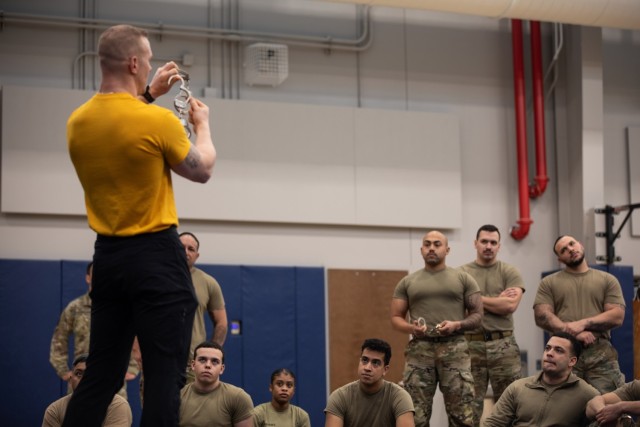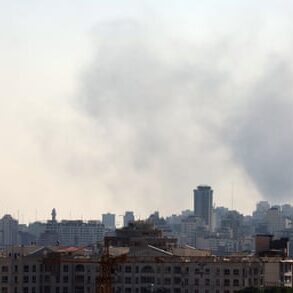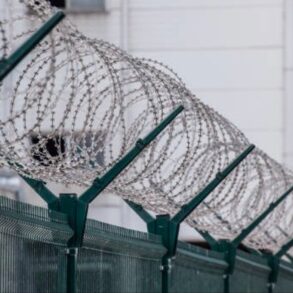ALBANY, N.Y. – More than 8,200 New York National Guard Soldiers and Airmen mobilized recently in response to a three-week correction officers’ strike that began at two correctional facilities and eventually impacted 42 of 45 New York prisons.
More than 12,000 officers walked off the job, violating a state law forbidding them from striking. The strike began Feb. 17, and Gov. Kathy Hochul declared it over on March 10.
Hochul signed an emergency order on Feb. 18 that directed the New York National Guard to mobilize and replace the striking Guards on Feb. 19.
At its peak, 6,846 Guardsmen were on duty, with more than 5,300 personnel in the prisons.
During the last correction officers strike in 1979, then-Gov. Hugh Cary deployed 12,000 National Guard personnel to replace striking prison guards.
The Guard Soldiers and Airmen deployed by Hochul watched over inmates in medium-security prison dorms, maximum-security cell blocks and minimum-security campuses. Their duties included conducting head counts, delivering meals and monitoring special housing units for inmates in solitary confinement.
Maj. Gen. Ray Shields, the adjutant general of New York, said he was proud of how the Soldiers and Airmen rose to the challenge.
“Their response to the prison strike and the ongoing staffing shortages of the Department of Corrections was phenomenal,” Shields said.
“They endured involuntary mobilization, austere living conditions, stressful duty, unfamiliar interactions with incarcerated individuals, long days and nights, and uncertainty when the mission would end,” he said.
“And most significantly,” Shields said, “being away from family, friends, and work, our service members answered the call and went above and beyond what I could ever expect.”
Despite the official end date of March 10, more than 4,400 Soldiers, Airmen and Naval Militia members remained on duty on April 1, when the mission transitioned into a volunteer-only force.
The governor directed Guard Soldiers and Airmen, joined by members of the Naval Militia, to remain on duty to ensure the understaffed correction officers’ force could conduct duties without excessive overtime.
Joint Task Force-Sentinel, operating out of the Thompson Road Armory at Hancock Field Air National Guard Base in Syracuse, oversaw 3,135 Soldiers and Airmen as of April 7. Those Soldiers and Airmen supplemented 10,000 correction officers who returned to work.
The goal was to shrink the force further and bring more volunteers on board.
The initial mobilization order on Feb. 18 was for New York Army National Guard units.
The commanders of the 27th Infantry Brigade Combat Team, the 153rd Troop Command, and the 369th Sustainment Brigade were each assigned operational areas and units across the state.
The 153rd was responsible for Western New York prisons, the 369th handled prisons in the Hudson Valley and the 27th Brigade supported Central New York and New York’s North Country, the Adirondacks and the region along the Canadian border.
The 42nd Expeditionary Combat Aviation Brigade also was placed on active duty to move people and supplies quickly across New York.
For example, three UH-60M Black Hawks picked up 1st Battalion, 69th Infantry Soldiers at a baseball field in the Bronx on Feb. 20 and transported them 250 miles north to Bare Hill Correctional Facility near Malone.
The aircrews flew more than 600 hours and transported 1,050 passengers by the end of the mission.
Additional correction officers began walking off the job when advance parties arrived at some prisons on Feb. 18. The Soldiers and supervisors remained to handle those officers’ duties.
Supporting the New York Department of Corrections and Community Supervision (DOCCS) was familiar to some units such as the Auburn-based 102nd Military Police Battalion, whose federal military role includes establishing and operating military prisons.
However, planning and executing prison operations was new for other units such as the Buffalo-based 152nd Brigade Engineer Battalion and Niagara Falls-based 2nd Squadron, 101st Cavalry Regiment.
Capt. Timothy Sullivan, commander of the Brigade Engineer Battalion’s military intelligence company, said his Soldiers learned on the job at Orleans Correctional Facility in Albion.
“They were able to adapt, communicate, follow orders and do the mission to the best of their ability,” Sullivan said.
Soldiers worked in pairs or groups of three to ensure safety.
Spc. Tamia Grant, an automated logistics specialist in the 101st Expeditionary Signal Battalion, worked in the Special Housing Unit, which is the solitary confinement area, of Eastern Correctional Facility in Napanoch.
She spent 12-hour shifts checking on inmates every 30 minutes. Leaders worked hard to ensure the Soldiers were comfortable, Grant said.
“My leadership is doing an amazing job,” Grant said.
“If we have any comments, questions or concerns, they have an open-door policy.”
“We can go to them and tell them maybe, like, we’re not feeling comfortable in an area, and they’ll take the proper precautions to move us around and switch us for different shifts,” she said.
Leaders at all levels visited prisons to check on the troops and the mission.
“I need to see what my Soldiers are experiencing,” said Col. Patrick Clare, the commander of the 369th.
Col. Christopher Guilmette, commander of the 153rd, compared what he saw on his visits to stories of the 1979 prison strike he had heard from his father, who served in the Army Guard then.
“In ’79, the responding Guardsmen had to cross the correction officers’ picket line to enter the facility, and the striking correction officers were resistive and violent,” Guilmette said.
“Supplies and care packages had to be flown by helicopter into the prison perimeter to avoid crossing the picket line,” Guilmette said. “I am glad we did not encounter anything close to that situation.”
As the mission began, conditions were austere. Soldiers lived inside the prisons, sleeping on cots in unused gyms, dorms or wherever they could find space.
Living inside the prison could be overwhelming, said Pvt. Cornell Ashby, an automated logistical specialist in the 133rd Composite Supply Company.
“Some days, I wake up and I feel like a Soldier,” said Ashby, who was assigned to Fishkill Correctional Facility. “Other days, I see the barbed wire and it feels like I’m something else.”
Army Guard units mobilized first with 6,673 Soldiers who were part of the mission. Also, 1,397 members of the New York Air National Guard were assigned to the Army Guard brigades to reinforce units already in the prisons. Eventually, 185 Naval Militia members also went on duty.
Conditions improved as the mission progressed. Starlink internet systems helped Soldiers and Airmen keep in touch with families, be entertained and work on academics. The systems also made it easier for companies across the state to communicate with their headquarters.
Catered meals and DoorDash food deliveries replaced meals, ready to eat.
Mattresses replaced cots, and Soldiers and Airmen moved to hotels when possible. The Division of Military and Naval Affairs contracted with 125 hotels and motels across the state for rooms.
Personnel also received days off when possible.
“Soldiers are trained to adapt to difficult conditions until we can resolve those difficulties,” said Capt. Saul Rodriguez, commander of the 133rd Composite Supply Company. “But we are always actively working to fix their conditions so they can succeed.”
“Internet access was a big boost to morale before we were able to get hotel rooms, because it enabled them to take a mental break,” he said.
“Morale got a lot better in that second week when we could get them into hotel rooms,” he said.
Spc. Justin Hall, a member of Alpha Company of the 427th Brigade Support Battalion who was assigned to Auburn Correctional Facility, said his unit leaders looked out for the Soldiers.
“Our leadership does rounds. They will check on every floor, make sure every Soldier is perfectly fine. If we need anything, they will get it for us,” Hall said, adding that his hours were fair and he got about seven hours of sleep daily.
“We had Walmart runs to get, you know, personal needs and stuff like that. They made sure we were fed, and we had showers overall,” he said.
Grant said he also appreciated the governor’s decision to compensate Soldiers for the rigors of the mission. They received retroactive basic housing allowance pay and $2,000 special duty pay each pay period.
“I feel like the TAG (the Adjutant General) and the Army National Guard, is doing a phenomenal job with making sure everyone gets their pay and just keeping us updated on everything and not withholding information,” she said.
“As soon as they get the information, they’re putting it out immediately,” Grant added.
The service members did more than keep order in the prisons.
Pfc. Quintel Turner, a combat engineer with the 152nd Brigade Engineer Battalion, defended an inmate during a violent attack by other inmates.
Air National Guard Staff Sgt. Austin Basile, an Air Force structural maintenance specialist from the 106th Rescue Wing, saved inmates from overdosing two separate times.
The 106th Regional Training Institute partnered with DOCCS to create a training program to prepare Guardsmen for the continuing mission. The one-week course, held at DOCCS headquarters in Albany at Camp Smith and Groveland Correctional Facility, shared basic correction officer skills.
“It’s teaching them and getting them familiar with protocols, procedures, things that may occur in prison, drug awareness, gang awareness, how they operate in the prison,” said Sgt. 1st Class Brian Lopez, the Noncommissioned Officer in Charge of the training program.
https://www.facebook.com/TheNationalGuard
This post was originally published on this site be sure to check out more of their content.







